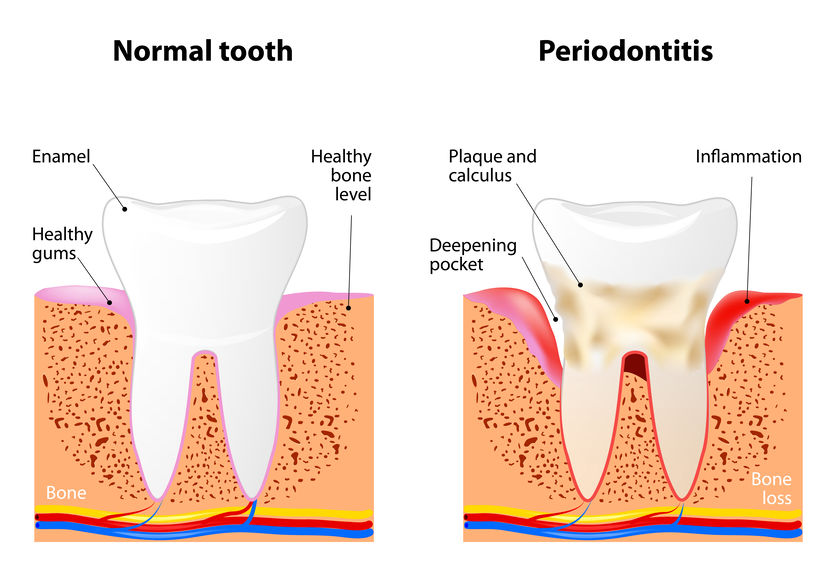Dental implants have become part of the mainstream in dental treatment and the replacement for lost teeth. As with any new treatments, the complications come to light as the treatment modality develops and more and more studies are done on the patients treated over a longer period of time.
An important question to answer here is with patients with dental implants, what is the incidence or prevalence of peri-implantitis? The answer stems from the results from 18 studies which indicate that the prevalence seems to be in the order of 20% of patients, and 10% of implants over a period of 5-10 years following implantation.

A systematic literature review of the surgical management of Peri-implantitis concludes that the available evidence does not allow for any specific recommendations. However, all the studies point to decontamination and/or modification of the exposed titanium surface and resolution of the active infection as the most important and primary prerequisite for any degree of success.
The reported outcomes must be viewed in the context of the varied peri-implantitis case definitions and the severity of the disease, as well as the specific design of the different studies.
The studies with the best outcomes had the following factors included in their protocols:
1. All necessary periodontal therapies were completed prior to the treatment of the affected implants.
2. Defect morphology was specifically described and access to the implant surface to be debrided was a significant factor in obtaining thorough decontamination.
3. All protocols included the use of bone or bone substitute grafts.
4. All protocols used membrane barriers.
5. All protocols included a 3 monthly or less frequency for professional maintenance.
The conclusion here is that the review failed to reveal any correlation between any particular method and positive clinical outcomes, but pointed to debridement and decontamination as primary requirements for success. In all cases, the negative impact on patient expectations were noted as requiring adjustment.
According to the new classification, when describing periodontitis, we now must clarify the stage and extent, and grade the progression with anticipated treatment response. The staging of periodontitis is based on both severity and complexity of management.
Populations Affected by Peri-Implants
There are two patient populations affected by peri-implantitis – those who lost teeth and had dental implant replacement due to fractures or un-restorable conditions, and those who had pre-existing periodontitis and its consequences leading to tooth loss and dental implant treatment.

Periodontitis is a inflammatory diseases affecting the periodontium, the tissues that surround and support the teeth
An implant is not a tooth. In essence, it is more susceptible to gingival and mucosal inflammation than teeth due to the absence of transceptal fibers and a true connective tissue attachment that creates a seal from bacterial invasion.
It is important to identify the category for each patient and treat accordingly. A key point is that all periodontal disease must be eliminated prior to implant treatment and most certainly during the treatment of ailing and failing implants.
IMPLICATIONS FOR PATIENT CARE
Classification
Early: Probing depth greater than 4mm and Bleeding on Probing with possible Suppuration Bone loss less than 25% of implant length.
Moderate: Probing depth greater than 6mm and Bleeding on probing with suppuration Bone loss 25%-50% of implant length.
Advanced: Probing depth greater than 8mm. Bone loss more than 50% of implant length.
Peri-implantitis Treatment – Essential Factors for Success:
1. Case Diagnosis and Selection as early as possible by annual recall examination and radiographic analysis. An important determination is whether the peri-implant infection is above or below bone level?
2. Surgical Access is important:
– for Adequate blood Supply
– for Surface decontamination
– for Defect debridement
– for Defect regeneration
– for Complete Coverage
3. Access for Removal. Replacement, and/or Modification of the Prosthesis.
4. A sound protocol for Professional Maintenance.
5. Excellent Personal Oral Hygiene.
Our mission
It is the mission of this office to provide our patients with the highest level of excellence in oral health care.
Our team is thoroughly committed to excellence for our patients; you’ll be treated with dignity and respect in a trusting, open, honest environment and the confidential nature of your personal information will be recognized and respected.
Decisions are made with our patients on the basis of consensus, valuing diversity of opinion, in an environment that fosters mutual respect.

